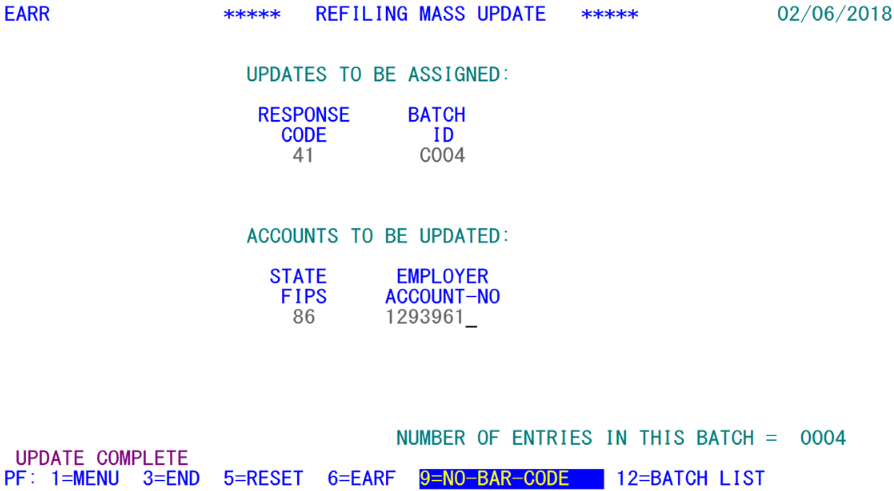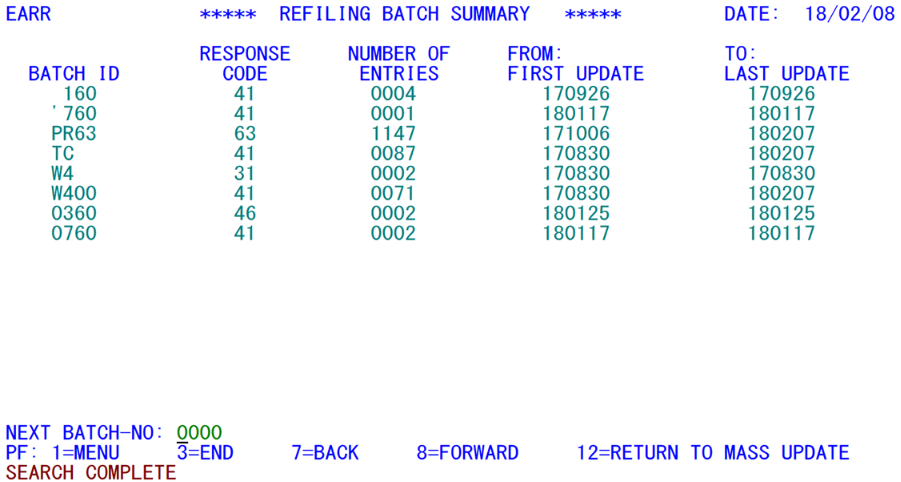05 earr mass update refiling data batches
EARR - Mass Update of Refiling Data in Batches
| Program IDS: | EARRP01, EARRP02 |
|---|---|
| Mapsets: | EARRMS1, EARRFM2 |
| Input Files: | None |
| I/O Files: | Lookup File (ES2LKUP), Refiling Master File (EARREF) |
This transaction is used for mass entry of data from returned refiling forms. There are two screens present. The first (shown above) contains very few fields. Yet, the screen can be quite useful for processing a substantial portion of the refiling forms returned by the employers. There are methods available whereby the data entry speed can be increased in a manifold manner. The processes involved with this screen are described in the paragraphs that follow.
Only four fields are represented for data entry on this screen, listed on two lines. The top line allows for the entry of a response code and refiling batch ID code. This generally refers to a physical batch or stack of returned refiling forms; of course, since the refiling process is more automated with CARS, there is little need for this screen. Some of the batches may be established by response code, so that all of the forms can be entered in one round. Others may represent multiple response codes. The purpose of having these two fields listed separately is to keep them from being required for all data entry operations. The reasoning behind this will become apparent shortly.
The second line of entered fields includes the state FIPS code and the 10-digit U-I account number. The U-I does not need to have leading zeroes entered, thus speeding up the assignment of accounts to a batch. The State FIPS code doesn't go into the data at all. It is listed solely because it is included in the barcode printed on the refiling forms. The Enter key is pressed after a FIPS code and account number have been specified, loading the SESA ID into the Refiling File data, ignoring the SESA ID, and recording the update in the Refiling Transaction File. As records are added to the batch, the forms count (shown in the lower, right-hand corner of the screen) will be incremented. This can serve as the "measuring rod" to let you know when a batch is full enough to file away so another batch can be initialized. Batch information is stored in the Lookup File within the Refiling Batch Control ("BC") records.
You will notice there is no code present on this screen; there is no expectation of a code change here, but just that the codes (the county, the ownership, the NAICS, the sub-county zone or township, and the MEEI code) are correct, which is normal for this update.
The true advantage of this screen is its use with a barcode scanner. Since the refiling forms come complete with a barcode identifying the State FIPS and the U-I account number, a scanner gun can read the barcode, passing the information directly onto the screen as though the U-I account information were being typed in directly. There are different varieties of scanner guns, however. Some send only the scanned numeric data, while others can append an Enter key indication to the data feed. This latter type is far preferable to the former, since it requires no additional keystrokes for associated account numbers to batches and response codes. This means that a stack of over 100 returned forms could be scanned in under three minutes, compared to close to ten minutes if the added Enter key must be typed for each form. Of course, manually typing all of the account numbers in that stack would take substantially more time to perform, with the added risk of typographic errors in the data entry.
Not all States use scanner guns, however. Those who enter the U-I account numbers manually do not want to deal with the added burden of entering the State FIPS code each time as well, especially when it is not even needed in the first place. To assist the non-scanning States, the F9 key provides a toggle between entry and non-entry of the State FIPS code. The sample screen (shown above) is set up for the SESA-ID-only entry. The yellow description of the F9 key ("9=SCAN-BAR-CODE") shows what the status will be the next time the F9 key is pressed. When the screen is first displayed, the description appears as "9=NO-BAR-CODE", since the barcode entry (i.e., including the State FIPS code) is expected. Although the keying of U-I's is not as quick as clicking the bar code scanner, an accomplished data entry person can still be quite productive.
Note: When pressing the F9 key to toggle between the two entry modes, the top line (response code and batch ID) must be re-entered. The system resets these fields, expecting that a new batch will be started.
Refiling form data entry often requires more processing than simply assigning a response code and batch ID. On the other hand, the majority of accounts that undergo the refiling process do not require any code changes. Two response codes are especially appropriate for EARR entry, namely '41' ("refiling form processed and no code changes were needed") and '31' ("refiling form received but not yet processed"). The '41' response code can allow a stack of forms to be scanned in without any further attention required. The '31' code acts in a similar manner to the MWR-received switch entry in the ES2R screen, because it notifies the system that no additional refiling forms need to be printed or sent out to the employer, even if we haven't yet loaded the information from these forms.
There can also be multiple response codes used within a batch of forms. If, for instance, there are 75 forms processed, 52 without any code change, and the remaining 23 with at least one code change, the response code could be set to '41' for the first portion of the forms, then changed to '31' for the remaining forms (since they need further work, but can be coded as received). To enact the response code change in mid-stream, simply tab up (or point-and-click to move the cursor) to the response code field and enter the new value.
Two other specialized function keys are used in this screen. The F6 key allows for transfer to the establishment list screen (EARF). This can assist in reviewing the accounts that have been inserted into a specific batch. F12 transfers control to the second EARR screen, which shows all of the batch ID codes with associated statistics relating to each batch. A sample of this screen is displayed below:
Notice that this is the only screen with a "YY/MM/DD" date format in the upper, right-hand portion of the screen; all of the reset of the screens have a "MM/DD/YYYY" format. The sample screen depicts the information found on this screen, including the response code, number of accounts associated with the batch, and the first and last dates during which updates were made to this batch. The batch ID is an alpha-numeric four-byte field used to identify a group of refiling respondents. You can note the scarcity of entries here, due primarily to the automation of entries with the CARS process, entering data with the 114* and 121D jobs.
The identification of batches is loose, as this refers to physical batches, which are bundles of forms that have been processed together. The response code field denotes the first response code that was assigned to an account within this batch. Yet it is possible for many different response codes to be used for the forms in an individual batch, so this field holds little tangible value toward defining the contents of a batch. Since the batch ID can hold both alphabetic and numeric characters, the sort sequence appearing on the screen will show alphabetic characters ahead of numeric values. The first and last update fields use the 6-digit yymmdd format, without separating characters (like hyphens or slashes) as is the standard for most date displays on EXPO and EARS screens.
The 'Number of Entries' field shows how many establishments have been associated with this batch, regardless of their assigned response code. The 'First Update' date identifies the date on which the batch was first created. The 'Last Update' date, as the name implies, is the most recent date for which the batch received a new addition. All of this information is maintained in the Batch Control ('BC' record type) records on the Lookup File.
This screen is intended to be an inquiry-only facility to show which batches are present in the refiling system. No update is conducted with this screen at all. Once inquiry has finished here, the F12 key should be pressed to return control to the primary EARR screen. Each year, all batches are purged from this file by Job 100A, as part of the creation of the new Refiling File for the next refiling cycle.
Related Links

